English 


| Availability: | |
|---|---|
Fiber optic cable, twisted pair cable, and coaxial cable are the three major types of network cables used in telecommunication systems. As a leading supplier of Ethernet network cables, Tangpin Technology integrates R&D, production, and sales. Tangpin's cables products are not only sold well in various cities and regions in China but also exported to foreign markets, such as Southeast Asia, Central Asia, Europe, Africa, South America, North America, etc., all have the footprint of Tangpin's twisted pairs cables in these places.
Our customers who buy Tangpin's Ethernet network cable come from various industries in the telecommunication field. High-quality products and affordable prices always make our customers Satisfied with us.
A twisted pair consists of two conductors (normally copper wire), each with its own plastic insulation, twisted together, one is used to carry signals to the receiver, and the other is used only as a ground reference. Twisted pair (TP) is the most commonly used transmission medium in integrated wiring engineering. Twisted pair cables are generally made of two 22-26 gauge insulated copper wires intertwined with each other, and the name of "twisted pair" comes from this. Twisted pair cable wires are twisted around each other to decrease obstruction from other twisted pairs in the cable.
This kind of cable consists of color-coded pairs of insulated copper wires, that's why sometimes we call it as copper twised pair cable. The twisted pair cable wire is an Ethernet computer network, which was primarily developed for computer networks. Thus the twisted-paired cable also can be known as Ethernet cable, is a kind of network cable. It can be used to connect the LAN computers, modems, switches and routers, and other nework equipments.
Parameters | UTP Cable | STP Cable |
Full Form | Unshielded Twisted Pair Cable | Shielded Twisted Pair Cable |
Structure |
|
|
Price | Cheaper than STP | Costlier than UTP |
Weight | Lighter than STP | Heavier than UTP |
Noise / Interference | Prone to noise and interference | Less prone to noise and interference |
Data Speed | Support slower speed than that of STP | Support higher speed than that of UTP |
Grounding of cable | Not required | Required |
Target depolyments | Locations less prone to interference like offices and homes | Locations prone to interference like factories and airports |
UTP (Unshielded Twisted Pair) wiring consists of two insulated copper wires which have been twisted around one another, while without any metal shielding layer only with an PVC or other insulating material wrapped. UTP cables are of small diameter and it doesn’t need grounding. Since there is no shielding for UTP cabling. The UTP is the most commonly used twisted-pair cable in networking media, as its price is relatively cheap, the networking is flexible, and it is easier to install. | STP (Shielded Twisted Pair) is similar to unshielded twisted pair (UTP), while apart from the insulator, the twisted wire pair itself is with an extra foil wrapping or a metal shield or copper braid jacket to help shield the cable signals from interference. Compared with UTP cable, the STP cable is costlier but supports a higher transmission rates across a longer distance. |
This cable comes with braided or foil shielding, which is usually made of copper or another conductive polymer. Shielding reduces electrical noise and improves connection quality. Cost of labor is higher compared with UTP.

Cat.1, Cat.2, Cat.3, Cat.4, Cat.5, Cat.5e, Cat.6, Cat.6a, Cat.7, and Cat.8 TP network cables. Each category of twisted pair cabling was designed for a specific type of communication or transfer rate.
Among them, Cat.1, 2, 3, 4, & Cat.5 are outdated and not used in any modern LAN network. While Cat.7 & Cat.8 are still the new technology and not commonly used. Cat.5e, Cat.6, Cat.6a are the commonly used twisted-pair cables. Tangpin offer customized Twisted Pair cables of the below categories:
Type | Cat.5e | Cat.7 | Cat.8 | ||
Bulk Cable Picture |
|
|
| ||
Cable structure |
|
|
|
|
|
Speed | 1000Mbps | 1000Mbps | 10Gbps | 10Gbps | 25/40Gbps |
Maxi Distance | 100M | 100M | 100M | 100M | 30M |
Bandwidth | 100Mhz | 250Mhz | 500Mhz | 1000Mhz | 2000Mhz |
Twist Conductor | 4 | 4 | 4 | 4 | 4 |
AWG | 24-26AWG | 22-24AWG | 22-24AWG | 22-24AWG | 22-24AWG |
Application | Home, Office | Enterprise | Enterprise | Data Center | Data Center |
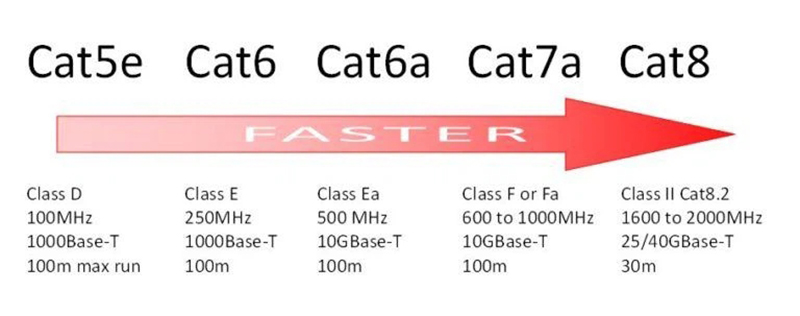
Ps. All the twisted pair of the above mentioned categories cables can be unshieled or shieled. Tangpin offer CAT5e UTP, Cat5e STP, Cat6 UTP, Cat6 S/FTP, Cat6a UTP, Cat6a S/FTP, Cat7 S/FTP and Cat8 S/FTP are available. Gennerally, the default color is blue. Customized color is available in TANGPIN.
Oxygen Free Copper (OFC) wire, also known as solid copper wire or pure bare copper wire, extremely pure copper with very little oxygen content, is the highest conductivity copper cable wire that is refined to reduce the amount of oxygen to less than 0.003%, the total impurity content to less than 0.05%. and the purity of copper to more than 99.95%.
The copper clad aluminum (CCA) wire is an electric conductor composed of an inner aluminum core and an outer copper cladding. It is significantly lighter and weaker than pure copper wire or oxygen-free copper wire. CCA wire isn't compliant with TIA standards, but it's a cheap aternative.
Type | oxygen-free copper (OFC) wire | copper clad aluminum (CCA) wire |
Structure |
|
|
99.95% Copper Purity | Yes | No |
Transmission Distance | Upto 100M | Upto 50M |
Performance | Perform well up to distances of 100 meters. | When using a CCA cable, its performance can start decreasing at a distance of 10 meters. |
Price | Expensive | Cheap |
Benefits of Oxygen Free Copper wire Cable and Bare/Pure Copper Wires:
● More resistant to corrosion. It will give a longer shelf life. More safer.
● A high melting point and high heat resistance, which is beneficial in extreme heat and humid conditions
● Durable and long-lasting suitable for most of the electrical appliances
● It can be used in a variety of industries like manufacturing, electrical, marine and telecom companies.
We supply both the OFC and the CCA cables. Customers can choose from them depending on their needs.

PVC cable jacket
PVC stands for Polyvinyl Chloride. A PVC cable has a jacket that gives off heavy black smoke, hydrochloric acid, and other toxic gases when it burns. Its price is a little cheaper than that of LSZH materials.

LSZH cable jacket
LSZH means Low Smoke Zero Halogen. It's more rigid and has a flame-resistant jacket that doesn't emit toxic fumes even if it burns. It is usually cost more than the equivalent PVC, and certain types are less flexible.
Whether you choose PVC jacket, or LSZH jacket depends on where you're going to run the cable. We offer customized services according to your requests.
As a leading carrier-class Ethernet network cable supplier, TANGPIN manufactory has more than 15 years of experience, which has enabled Tangpin suppliers to form a set of mature R&D, production, sales, and after-sales service processes. Provide sufficient security for your purchase.
Oxygen-free copper core network cable, oxygen-free copper is a copper conductor, with relatively stable physical properties and long service life; oxygen-free copper Ethernet network cable has high purity and low resistance.
8-core 4-pair twisted-pair cable, tight and precise pitch control can effectively offset the signal crosstalk between the pairs.
Stretching, folding, non-knotted, durable, and non-breaking.
Fully compatible with RJ45 interface network, support notebooks, desktop routers, set-top boxes, smart TV switches, digital printers.
Tangpin’s professional production team guarantees the product production cycle and provides a cycle guarantee for your use or supply.
Tangpin Ethernet network cables have provided a full range of services in all parts of China and all corners of the world and has been praised by customers many times. Because Tangpin manufactory have a rich variety of cables, it not only has Cat5, Cat5e, Cat6, Cat6a, Cat7, and Cat8 but also has a variety of shielded and unshielded cables, which can be used for you whether you use it indoors or outdoors.
Tangpin supplier is located in Shanghai, a beautiful city on the coast of the East China Sea. Our factory is located in Jiaxing Industrial Park, with convenient transportation. You can choose to go to Shanghai port or Ningbo port, which can also meet your air and rail transportation needs.
Our Ethernet network cables are made of real PVC environmentally friendly materials, feel free to use them.
The twisted pairs cables and crystal plugs of cables are made in accordance with international standards, and the transmission band and transmission rate are guaranteed.
Tang product network cable length can be customized according to demand.
The color of the network cable can be customized according to requirements.
Authoritative quality certification, first-tier supplier telecom-level quality, buy with confidence. The product quality has passed the quality certification: CE/ROHS/ISO9001/UL.
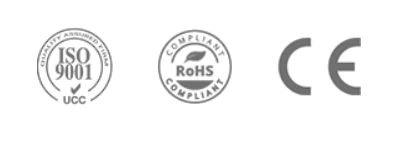
Our network cable complies with TIA/EIA568-A vs TIA/EIA568-B industry standards.
Home improvement wiring, Internet cafe wiring, office cloth, line computer room wiring, etc., multi-scene applications.
The price of Tangpin cable is more attractive and more affordable than if you buy it from a trader or distributor.
Pre-sales: You only need to provide a few questions and product information to receive the quotation.
Tangpin staff will be available 24 hours online and can solve problems for you anytime, anywhere.
Problems encountered during after-sales installation or use: Tangpin will arrange professional and technical personnel for guidance until you are satisfied.
Tangpin's philosophy is: customer satisfaction is our biggest brand.
Tangpin’s goal is to develop together with customers.
Θ What is the difference between UTP, STP, FTP, SFTP, and ASTP?
Θ The same type of Ethernet network cable can have various shielding types?
Θ What are the characteristics of the Ethernet network cable?
Θ How to identify the quality of the Ethernet network cable?
Θ How to prevent Category3 cables from being mixed with the Category5 cables?
Θ What is the difference between Category 6 cable and Category 5 cable?
Θ How many different types of Ethernet network cables are there?
Θ What kind of material is better for the conductor core of the Ethernet network cable?
Θ What scenarios can the Ethernet network cables be used in?
Θ Is there a minimum order quantity for the network cable in Tangpin manufactory?
Θ What is the difference between Category 6 network cable and Category 6e network cable?
Θ What are the names of the network cable crystal connectors?
Θ Are Category 7 cables also divided into shielded and unshielded types?
Θ What is the biggest difference between Category 8 network cables and other network cables?
They are generally made of metal or glass, can be used to transmit information within the network. There are three commonly used Ethernet network cables: twisted pair, coaxial cable, and optical fiber cable (optical fiber). Twisted pair is a data transmission line composed of many pairs of wires, which are used to connect to RJ45 crystal heads.
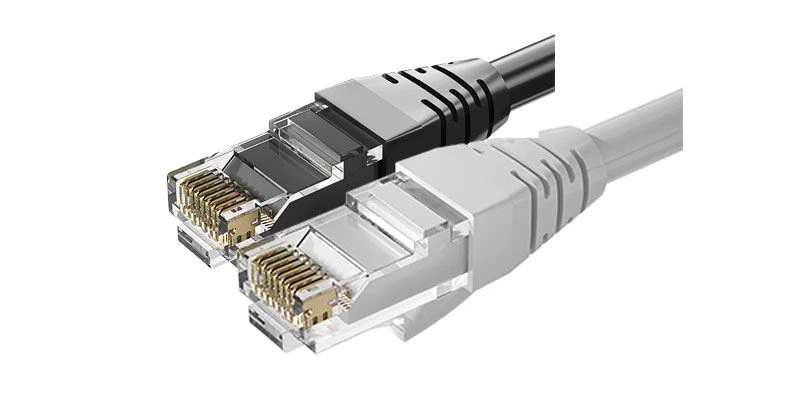
The twisted-pair cable is the connection line that connects the computer and the computer, and the computer and other network devices. Commonly used network cables are twisted pair and coaxial thin cables.
Twisted pair is a data transmission line composed of many pairs of wires. It is characterized by the low price, so it is widely used.
The twisted-pair cable is composed of four copper wires that are twisted with each other covered with insulating material, and are wrapped in an insulating sheath. It can reduce the interference caused by clutter and suppress the attenuation of the signal in the cable.
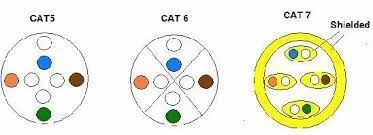
(1) Twisted-pair wire: as a transmission medium, it is made up of two thin copper wires wrapped with insulating materials twisted with each other in a certain ratio.
(2) Why to twist the two wires in twisted pairs: Because this mutual entanglement changes the original electrical characteristics of the cable, it can not only reduce its own crosstalk but also prevent the signal on other cables from pairing the pair of wires to the greatest extent. Interference on the cable.
According to the different shielding methods, the twisted pair is divided into shielded (Shielded Twisted pair-STP) and unshielded (Unshielded Twisted pair-UTP).
UTP: Unshielded twisted pair. This type of wire is the most commonly used wiring system wire in the general market. It is used for ordinary network applications with a transmission bandwidth below 250MHz and no special performance requirements. The overall performance meets the requirements, the price is cheap, construction and maintenance convenient. However, the maximum performance limit of this type only supports the cabling system of Category 6 Ethernet network cables.
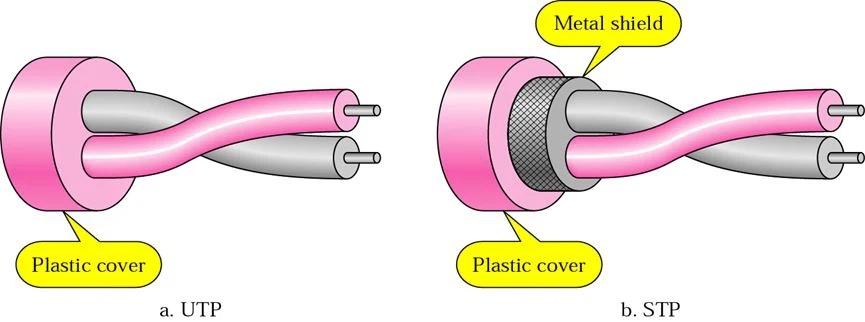
STP: Independently shielded twisted-pair wire, adding an aluminum foil layer outside the core wire, and each pair of wires has an aluminum foil shielding layer to reduce signal attenuation. There is also a metal braided shielding layer for every 4 pairs of wires, which has reached the structural standard of the seven types of Ethernet network cables. It is suitable for high-speed network and high confidentiality transmission, can support future application updates, can unified wiring platform, and transmit multiple media information together.
The difference is show in the following table:
UTP | Unshielded Twisted Pair | has no aluminum foil and braided shielding layer. |
STP | Shielded Twisted Pair | is the general term for shielded twisted pair cables, which can be divided into single-shielded and double-shielded cables, namely FTP and SFTP. |
FTP | Foil Twisted Pair | stands for single-shielded twisted pair of aluminum foil, FTP has an extra layer of aluminum foil compared to UTP. |
SFTP | Shielded Foil Twisted Pair | stands for double-shielded twisted pair, SFTP adds a braid on the basis of FTP. |
ASTP | Armored twisted-pair shielded | is a more special double-shielded cable. On the basis of the above double-shielded cable, the outer layer is a steel tape armor layer. When used, both ends of the steel tape armor layer Ground, and ground one end of the innermost shield. |
 | ||
Yes. As shown in the following figure:

There are many characteristics:
Long transmission distance and high transmission quality. | Due to the advanced processing technology used in the twisted-pair transceiver, the attenuation of the video signal amplitude and the attenuation difference between different frequencies by the twisted pair are excellently compensated, and the brightness and color of the original image and the real-time performance are maintained. |
Convenient wiring and high cable utilization. | A pair of ordinary telephone lines can be used to transmit video signals. In addition, any pair of Cat5 unshielded twisted pairs that are widely laid in buildings can transmit one video signal without additional wiring. Even if it is rewiring, Cat5 Ethernet network cables are easier than coaxial cables. In addition, there are 4 pairs of twisted pairs in a Cat5 cable. If a pair of wires are used to transmit video signals, the other pairs can also be used to transmit audio signals, control signals, power supply, or other signals, which improves the cable Utilization rate, while avoiding the trouble caused by separate wiring of various signals, and reducing the project cost. |
Strong anti-interference ability. | The Ethernet network cable can effectively suppress common-mode interference. Even in a strong interference environment, twisted-pair cables can transmit excellent image signals. Moreover, several pairs of twisted pairs in a cable are used to transmit different signals, and there will be no interference from each other. |
High reliability and easy to use. | Utilize Ethernet network cable to transmit video signals, and a dedicated transmitter must be connected at the front end, and a dedicated receiver must be connected at the control center. This kind of twisted-pair transmission equipment is cheap and easy to use. It does not require professional knowledge and does not require many operations. It is installed once and works stably for a long time. |
In addition to the above-mentioned features, Tangpin's twisted pair also has its own characteristics. Take the Cat6 cable as an example:
| Solid Conductor There is a reason for fast, thick copper cores are each composed of 1 independent core, multi-strand conduction, and low resistance. |
| Tightly twisted 8-core 4-pair twisted pair cable, tight and precise pitch control can effectively offset the signal crosstalk between the pairs. |
| Twisted-pair design Every two cores are twisted with each other to resist external electromagnetic interference and ensure the stability of the signal transmission. |
| Coil material Tensile, folding,non-knotted, durable, non-breaking, environmentally friendly PVC material. |
Gigabit Internet speed, faster to choose Tangpin's products! With Tangpin's Ethernet network cable, your network speed is different! · Category 6 cable Gigabit fast speed · Take care of the cross, reduce transmission loss · Thick gold-plated, stable speed · Environmentally-friendly PVC, resistant to bending and pulling |  |
The Internet is not stuck! 1000Mbps high-speed transmission rate, the signal transmission does not attenuate. · No delay in the game. · Download faster. · Watch movies more smoothly. |  |
Applicable equipment: fully compatible with RJ45 interface network, support notebooks, desktop routers, set-top boxes, only TV switches, digital printers. The access speed is 70.2MB/s, and the broadband is far greater than 500M. The above data are from the laboratory. |  |
Stable and non-dropping, each core is composed of 7 independent wires, and the network speed is more stable when multiple strands are bolted. |  |
Cross frame isolation, isolate four pairs of twisted-pair wires, reduce crosstalk and return loss during transmission. |  |
The body of the Ethernet network cable is soft and does not break: The outer cover is made of PVC material, which has good abrasion resistance, tensile resistance, and is more durable. |  |
The gold-plated connector adopts thick gold-plated contacts, which are resistant to plugging and unplugging, so it does not affect the network speed. |  |
Three-pronged chip, more full-contact: three-pronged structure chip, the contact is fully in contact with the copper core, and the transmission is more stable. |  |
Please ask us for technical support if you have workers who know how to repair it. If you do not have engineers, please send back the items, we can repair the items for you, or we will re-produce them for you.
There are more fake twisted-pair cables on the market than the real ones, and the fake cables have the same marks like the real ones. In addition to the false line, the following is the identification method of the cable:
(1) There are two pairs of four lines in Cat3, and four pairs of eight lines in Cat5.
(2) The outer rubber of the real thread is not easy to burn, while the outer rubber of the false thread is mostly flammable.
(3) The outer rubber of the fake Ethernet network cable will become soft at a higher temperature (above 40°C), while the real twisted pair will not.
(4) The copper core material inside the true wire is relatively pure, relatively soft, flexible, and not easily broken.
There are many situations in the market that pretend to be Category5 or Super Category 5 cables with Category 3 cables. If possible, you can find a 100-meter twisted pair cable and use the "Network Monitor" in Windows to test it on the spot. Category 5 cable can reach 100Mbps, while Category 3 cable is only 10Mbps.
Except that the traditional voice system still uses Category 3 twisted pair, Ethernet network cables are currently basically using Category 5 or Category 6 unshielded twisted pair. Although Category 5 unshielded twisted pair cables still support 1000BASE-T, they have gradually faded out of the cabling market because they are almost the same in price as Category 5 unshielded twisted pairs.
Although the price of Category 6 unshielded twisted pair is relatively high, it is slowly becoming the new favorite of integrated wiring because it has very good compatibility with the Category 5 cabling system and can support 1000BASE-T very well.
Category 6 cables have improved performance in terms of crosstalk and return loss. For a new generation of full-duplex high-speed network applications, excellent return loss performance is extremely important. The basic link model is canceled in the six types of standards. The wiring standard adopts a star topology. The required wiring distance is: the length of the permanent link cannot exceed 90 meters, and the channel length cannot exceed 100 meters.
There is no strict difference in transmission distance between Category 6 line and Category 5 super line, that is, the maximum transmission distance of a single segment is 100 meters. Of course, the transmission distance of Category 6 lines can be appropriately increased. The so-called 100 meters means that the 1000M bandwidth and other related technical indicators cannot be met after exceeding, which will cause problems such as speed reduction.
Category7 shielded twisted pair is a brand-new wiring system. Although it has excellent performance, it is expensive. The construction is complicated and there are fewer products to choose from, so it is rarely used in wiring projects.
Types of Ethernet network cables according to category and speed showing in the following table:
Cat1 | Cat1 is the most original unshielded twisted-pair copper cable in the ANSI/EIA/TIA-568A standard, but it was originally developed not for computer network data communication, but for telephone voice communication. |
Cat2 | Cat2 is the first unshielded twisted pair cable that can be used for computer network data transmission in ANS/EIA/TIA-568A and ISO2 category/A level standards. The transmission frequency is 1MHz, and the transmission rate is 4MBb/s. It is mainly used for The old token network. |
Cat3 | Cat3 is the first unshielded twisted pair cable that can be used for computer network data transmission in ANS/EIA/TIA-568A and ISO Class 2/Class A standards. |
Cat4 | Cat4 is an unshielded twisted pair cable used for token ring networks in ANS/EIA/TIA-568A and ISO Category 4/C level standards. The transmission frequency is 20MHz and the transmission rate can reach 16Mb/s. Mainly used for token-based LAN and 10BASE-T/100BASE-T. |
Cat5 | Cat5 is an unshielded twisted-pair cable used in ANSI/EIA/TIA-568A and ISO Category 5/Class D standards to run CDDI (CDDI is an FDDI network based on the twisted-pair copper wire) and Fast Ethernet. The transmission frequency is 100MHz, The transmission rate is up to 100Mb/s. |
Cat5e | Cat5e is an unshielded twisted pair cable used to run Fast Ethernet in SNSI/EIA/TIA-568B and ISO Class 5 standards. The transmission frequency is 100MHz and the transmission rate can reach 100Mb/s. Compared with Category 5 cables, Category 5e has greater improvements in the four main indicators of near-end crosstalk, crosstalk synthesis, attenuation, and signal-to-noise ratio. |
Cat6 | Cat6 is a kind of unshielded twisted pair cable specified in ANSI/EIA/TIA-568B.2 and ISO Category6/Class E standards. It is mainly used in Fast Ethernet and Gigabit Ethernet. Because its transmission frequency can reach 200-250MHz, which is twice the bandwidth of the super-category 5 line, the maximum rate can reach 1000Mb/s, which can meet the requirements of Gigabit Ethernet. |
Cat6a | Cat6a is an improved version of Cat6. It is also an unshielded twisted pair cable specified in ANSI/EIA-568B.2 and ISO Category6/Class E standards. It is mainly used in Gigabit networks. It is similar to Cat6 in terms of transmission frequency. Similarly, it is also 200-250 megabytes, and the maximum book eucalyptus tree can reach 1000Mb/s, but it has a great improvement in crosstalk, attenuation, and signal-to-noise ratio. |
Cat7 | Cat7 is the latest type of twisted pair in the ISO 7/F standard. It is mainly used to adapt to the application and development of 10 Gigabit Ethernet technology. But it is no longer an unshielded twisted pair, but a shielded twisted pair, so its transmission frequency can reach at least 500MHz, which is more than twice that of Cat6 and Cat6a, and the transmission rate can reach 10Gbps. |
Cat8 | Cat8 is supporting 2000MHz bandwidth and speeds of 40Gbps. These cables are specifically designed for Data Center and enterprise networks, and the price is more expensive. |
Of course Oxygen-free copper wire.
Oxygen-free copper is a conductor of copper;
The physical properties are relatively stable and the service life is long.
Oxygen-free copper Ethernet network cable has high purity and low resistance.
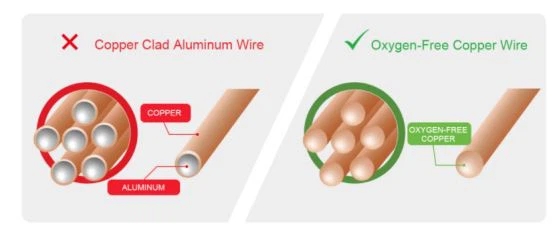
Ti is formed by twisting a pair of mutually insulated metal strip wires. In this way, it can not only resist a part of electromagnetic wave interference from the outside,but also reduce the mutual interference between multiple pairs of twisted wires.

Two insulated wires are twisted together, and the interference signal acts on the two wires that are twisted together (this interference signal is called a common mode signal). The common mode can be used in the differential circuit of the received signal. The signal is eliminated to extract the useful signal (differential mode signal). Twisted pair wire is used quite a lot in Ethernet networks and Token Ring networks, it is often used as the connection of bus-type topology structure or star topology structure.
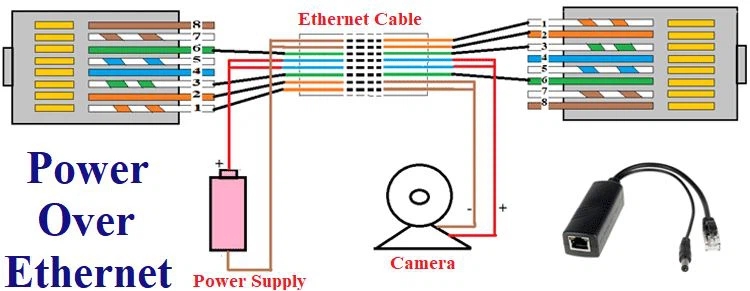
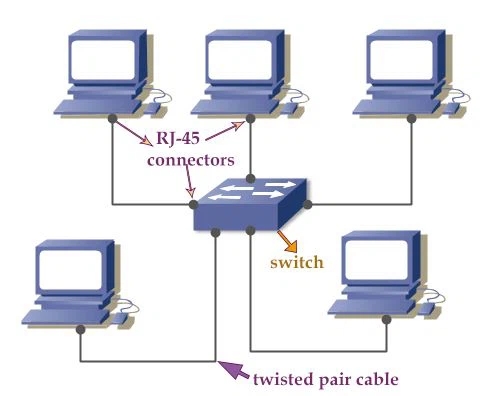
The internal wire pairs are tightly twisted in a counterclockwise direction. The method of twisting each other is beneficial to reduce internal crosstalk and reduce external interference. In a normal network environment, weak electromagnetic interference is parallel to the unshielded cable. There is no impact.




Cross-sectional view and plan view comparison:

Each pair of wires inside the Ethernet network cable is twisted in a counterclockwise direction, and the lay length of each pair is different. This mutual entanglement changes the original electronic characteristics of the cable, which can resist a part of external electromagnetic interference. It can be used to reduce the crosstalk problem caused by its own signal.
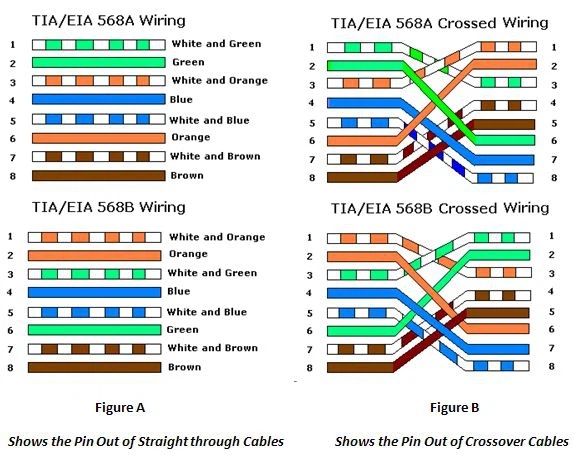
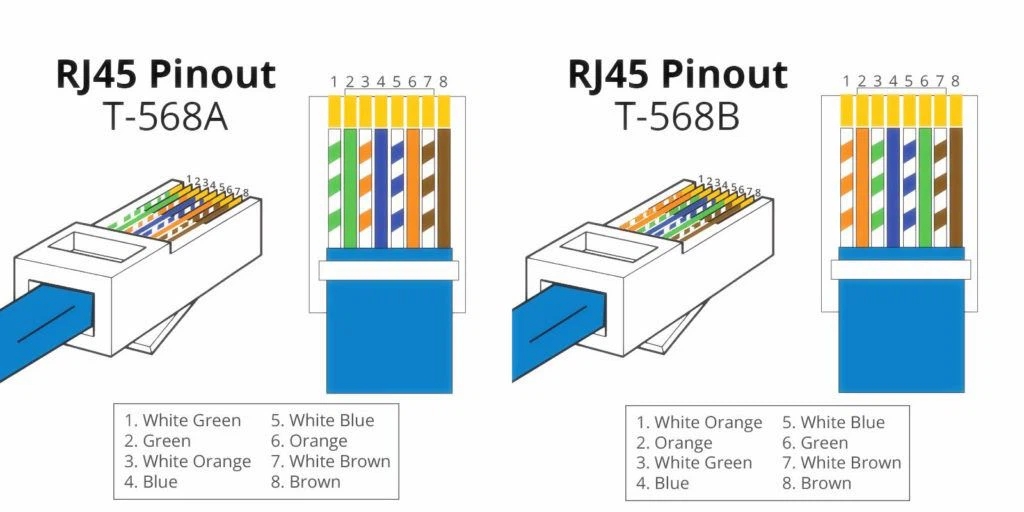
They can be used in the following scenarios.

Home decoration wiring
Home decoration, high-speed Internet access is not delayed.

Internet cafe wiring
Control all kinds of online games.

Office wiring
Fast network, higher office efficiency.

Computer room wiring
The computer room wiring is faster.
Tangpin's network cable jacket material: PVC and LSZH are all available, you can choose arbitrarily.
If it is Category 5e unshielded and Category 6 unshielded network cable, we have no MOQ. Because our sales volume in China is also very large, these two models have relatively high sales volume in China, and samples can be provided free of charge. Other network cables have MOQ, and free samples are subject to stock availability.
1) The transmission frequency is different:The transmission speed of the Category 6e network cable exceeds that of the Category 6 network cable. The transmission frequency of the Category 6 network cable is 250MHZ, which supports gigabit network speed, while the transmission frequency of the Category 6 network cable has been upgraded on the Category 6 network cable, reaching 500MHZ, supporting 10 Gigabit network speed.
2) The outer skin identification is different:Category 6 cables are different from Category 6E cables. Generally speaking, there will be manufacturer's information, cable logos, and scales on the cable jacket. The identification of Category 6 network cable is Cat6, and the identification of Category 6 network cable is Cat6a.
3) The thickness of the wire core is different: The super six network cable will be thicker because Cat6a has two layers of shielding layers, and the core will be thicker at the same time, Cat6 has a unique cross skeleton structure. The thickness of the wire core is an important indicator that affects the transmission rate, which is generally proportional.
4) Different core conductors:The conductor material of Category 6 unshielded network cable is 0.545±0.02mm, and the conductor material of other models and Category 6 super cable is 0.57±0.02mm. This is also the difference between the two, but because the gap is too small, it cannot be distinguished by the naked eye, so it is generally not judged from this aspect.5) The price is different:Cat6e cable is indeed more expensive than Cat6.
1) RJ-45
Both ends of each twisted pair are connected to network cards and hubs (or switches) by installing RJ-45 connectors.
The RJ-45 plug is a plastic connector that can only be inserted in a fixed direction and automatically prevents falling off. Both ends of the twisted pair must be installed with this RJ-45 plug in order to be inserted into a network card (NIC), hub (Hub), or Network communication is carried out on the RJ-45 interface of the switch.
2) RJ-11
The R-J11 interface is very similar to the RJ45 interface, but only has 4 pins (8 for RJ45). In computer systems, RJ-11 is mainly used to connect modems. In daily applications, RJ-11 is commonly found on telephone lines.
3) RJ-12
There is also an RJ-12 that is usually used for voice communication. It has the same structure as the first two but has six pins (6p6c). At the same time, there are also two types of six-slot four-pin (6p4c) and six-slot two-pin (6p2c).
4) Cat6a
Cat6a of crystal connectors also have their own varieties.
At present, the commonly used network cable crystal connectors are Cat5e plug, Cat6 plug, Cat6a plug, and Cat7 plug. Let's take a look at their relevant parameters through the table below:
Category 7 cable is no longer an unshielded twisted pair, but a shielded twisted pair, so it can provide a comprehensive attenuation-to-crosstalk ratio of at least 500MHZ and an overall bandwidth of 600MHZ. More than 2 times the line, the transmission rate can reach 10Gbps.
In Category 7 cables, each pair of wires has a shielding layer, and the four pairs of wires together have a common large shielding layer. From a physical structure point of view, the additional shielding layer makes the Category 7 cable have a larger wire diameter.
Therefore, there is no unshielded Category 7. If you need unshielded, you can buy Category 6 cable, but it cannot reach 10G.
Category 8 network cable is the latest generation of double-shielded (SFTP) network jumper. It has two wire pairs, can support a bandwidth of 2000MHz, and has a transmission rate of up to 40Gb/s, but its maximum transmission distance is only 30m, so it is generally used. Connecting servers, switches, patch panels, and other equipment in short-distance data centers.
Category 8 network cables, like Category 7 cables, are double-shielded and can be used in high-speed broadband environments, such as data centers and places with dense bandwidth, although the transmission distance of Category 8 cables is only 30 meters, which is far less than that of other types of cables, its transmission rate and frequency bandwidth is far more than other types.
Therefore, the difference between the eight types of cables and other types of network cables is relatively large, which is mainly reflected in the transmission rate, frequency bandwidth, transmission distance, and application environment.
The network cable is indispensable in network engineering. Its quality directly affects the network transmission rate. Let's see how to distinguish the quality of the network cable.
1: We arrange the shipping, by sea or by air. By air is express courier - FedEx/ DHL/UPS/TNT/EMS. By sea is to ship them by our agent company.
2: Clients assign a logistic company for the shipping, we follows their instructions and finish the delivery.
Yes, bundling is to be careful not to bundle the cables too tightly and not to kink, which will negatively affect the network and reduce the quality of the cables.
No - Ethernet cable suppliers are designed to be immune to interference in order to avoid mutual interference.
Sure, cat7 cables are backward compatible, which means you can use them with previous cables, including cat4, cat5, cat5e.
Product Name | Ethernet network cable |
Type | Cat5e/Cat6/Cat6a/Cat7/ Cat8 |
Shielding | UTP, STP, FTP, SFTP |
Number Of Conductors | 4 pairs |
Conductor Material | Solid bare copper |
Wire core | Oxygen-free copper |
Insulation Material | HDPE |
Rip cord | optical |
Jacket Colour | Blue/Gray/Black or customized on customers' request |
Jacket Material | PVC/LSZH/PE |
Max. Transmission Speed(at 100meters) | 1000Mbps/10000Mbps/10Gbps/25Gbps or 40Gbps |
Max. Bandwidth | 100 MHz/250Mhz/500 MHz/600 MHz/2000 MHz |
working temperature | -20℃ - +60℃ |
Bending radius | ≥10×out diameter |
Length | 0.5m/1m/2m/5m/customized |
Test | FLUKE |
Certification | CE/ROHS/ISO9001/UL |